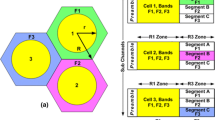Abstract
An improved radio resource allocation scheme with avoidance of major interferers is proposed and analyzed for the downlink of Fixed Broadband Wireless Access (FBWA) systems with full frequency reuse. The scheme is based on Enhanced Staggered Resource Allocation (ESRA) and permits the enhancement of the throughput per sector. Simulation results show a maximum downlink throughput per sector in excess of 44% and an increase of 10% with respect to ESRA is achieved, with Base Station (BS) selection procedure, while meeting a 15 dB signal-to-interference ratio (SIR).
Similar content being viewed by others
References
T. Monath, N.K. Elnegaard, P. Cadro, D. Katsianis, and D. Varoutas, “Economics of Fixed Broadband Access Network Strategies”, IEEE Commun. Mag., Vol. 41, pp. 132–139, 2003.
K. Chawla and X.X. Qiu, “Quasi-Static Resource Allocation with Interference Avoidance for Fixed Wireless Systems”, IEEE Journal on Selected Areas in Communications, Vol. 17, pp. 493–504, 1999.
T.K. Fong, P.S. Henry, K.K. Leung, X.X. Qiu, and N.K. Shankaranarayanan, “Radio Resource Allocation in Fixed Broadband Wireless Networks”, IEEE Transactions on Communications, Vol. 46, pp. 806–818, 1998.
K.K. Leung and A. Srivastava, “Dynamic Allocation of Downlink and Uplink Resource for Broadband Services in Fixed Wireless Networks”, IEEE Journal on Selected Areas in Communications, Vol. 17, pp. 990–1006, 1999.
V. Tralli, R. Veronesi, and M. Zorzi, “Power-Shaped Advanced Resource Assignment (PSARA) for Fixed Broadband Wireless Access Systems”, IEEE Transactions on Wireless Communications, Vol. 3, pp. 2207–2220, 2004.
Author information
Authors and Affiliations
Corresponding author
Additional information
Nicholas Vaiopoulos was bornin Lamia in 1977. He received his Physics degree and his M.Sc.degree in electronics and radio-communications from the University of Athens, Greecein 2000and 2003, respectively. Currently, he is working towards his Ph.D. degree on the resource allocation techniques with reference to wireless systems at the Department of informatics and Telecommunications at the same University. His research interests include broadband communications systems, scheduling algorithms and power control techniques for wireless systems.
Alexander Vavoulaswas born in Athens in 1976. He received his B.Sc. degree in physics and the M.Sc. degree in electronics and radio-communications in 2000 and 2002 respectively,both from the University of Athens, Greece. Currently he is working toward the Ph.D. degree on the radio resource allocation techniques with the same University. His research interest is focused on broadband wireless access and interference management. He is a student nmember of the IEEE.
Dimitris Varoutas holds BSc. degree in Physics, M.Sc. in electronics and radio-communi cations and Ph.D. in telecommunications systems and technoeconomics, all from the University of Athens. He is a lecturer in the Department of Informatics and Telecommunications of University of Athens and an adjunct assistant professor in the Department of Telecommunications of the newly founded University of Peloponnese. He has participating in numerous European R&D projects in the RACE I &II, ACTS, Telematics, RISI and IST framework in the areas of telecommunications and Technoeconomics. He is an adviser in several organisations including OTE and EETT (Greek NRA for telecommunications) in the fields of telecommunications, broadband and mobile services, licensing, spectrum management, pricing and legislation. His research interests are optical, microwave communications and technoeconomic evaluation of network architectures and services. He has more than 30 publications in refereed journal and conferences in the area of telecommunications, optoelectronics and technoeconomics. He is a member of IEEE and serves as reviewer in several journals and conferences.
Thomas Sphicopoulos received the Physics degree from Athens University in 1976, the D.E.A. degree and Doctorate in Electronics both from the University of Paris VI in 1977 and 1980 respectively, the Doctorat Es Science from the Ecole Polytechnique Federale de Lausanne in 1986. From 1976 to 1977 he worked in Thomson CSF Central Research Laboratories on Microwave Oscillators. From 1977 to 1980 he was an Associate Researcher in Thomson CSF Aeronautics Infrastructure Division. In 1980 he joined the Electromagnetism Laboratory of the Ecole Polytechnique Federal de Lausanne where he carried out research on Applied Electromagnetism. Since 1987 he is with the Athens University engaged in research on Broadband Communications Systems. In 1990 he was elected as an Assistant Professor of Communications in the Department of Informatics & Telecommunications, in 1993 as Associate Professor and since 1998 he is a Professor in the same Department. His main scientific interests are Microwave and Optical Communication Systems and Networks and Techno-economics. He has lead about 40 National and European R&D projects. He has more than 100 publications in scientific journals and conference proceedings. From 1999 he is advisor in several organisations including EETT (Greek NRA for telecommunications) in the fields of market liberalisation, spectrum management techniques and technology convergence.
Rights and permissions
About this article
Cite this article
Vaiopoulos, N., Vavoulas, A., Varoutas, D. et al. A Radio Resource Allocation Scheme for Fixed Broadband Wireless Access Systems with Avoidance of Major Interferers. Wireless Pers Commun 40, 479–487 (2007). https://doi.org/10.1007/s11277-006-9115-9
Received:
Accepted:
Published:
Issue Date:
DOI: https://doi.org/10.1007/s11277-006-9115-9




